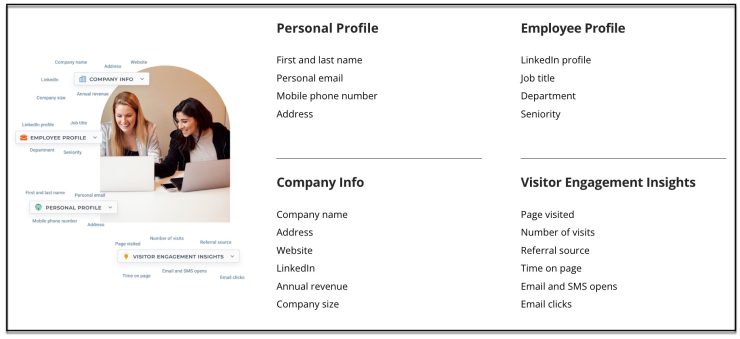Generating high-quality leads is the lifeblood of any B2B marketing strategy.
But separating the wheat from the chaff can be a major challenge without the right tools and processes in place.
That’s where lead scoring comes into play – assigning values to each lead based on their perceived level of interest and sales-readiness.
However, traditional lead scoring methods often overlook a critical piece of the puzzle: anonymous website visitor data. By tapping into this goldmine of behavioral insights, you can supercharge your lead qualification and follow-up efforts like never before.
Understanding Website Visitor Identification
At its core, website visitor identification technology allows you to unmask anonymous traffic hitting your site.
Using reverse IP tracking and other advanced techniques, these solutions match website visitors to actual businesses and companies.
This gives you an incredibly detailed view into the organizations engaging with your online presence. You can see which companies are visiting specific pages, how often they return, what content they’re consuming, and more.

Optimizing Lead Scoring with Visitor ID
There are a few ways to optimize your lead scoring with visitor identification:
1. Enrich Your Lead Data with Firmographic Details
One of the biggest benefits of website visitor ID is the ability to enrich your lead records with critical firmographic intelligence.
This additional context allows you to score leads much more precisely based on criteria like company size, industry fit, estimated annual revenue, geographic location, and corporate hierarchy including key decision-makers.
For example, a small software startup likely wouldn’t be scored as high as an enterprise financial firm with over 10,000 employees. But without visibility into these company details, it’s impossible to make those important qualitative distinctions.
2. Prioritize Leads Based on Behavioral Data
Of course, demographic information only tells part of the story when it comes to lead scoring.
To really zero in on “hot” prospects, you need insight into their level of active engagement as well. This is where behavioral scoring comes into play – analyzing activities like email opens and link clicks, content consumption patterns, website navigation paths, and frequency plus recency of visits.
Visitor identification gives you full visibility into these types of engagement signals from recognized businesses.
You can then map that behavioral data back to individual lead records for ultra-precise scoring based on their demonstrated level of interest.
3. Accelerate Follow-Up with Real-Time Alerts
One of the biggest advantages of visitor ID technology is the ability to receive real-time alerts when priority accounts hit your website.
This allows you to seize the moment and engage key leads with ultra-relevant, timely outreach. For instance, let’s say an identified visitor from a promising account views your pricing page multiple times within a short window.
That’s a clear buying signal that should prompt an immediate follow-up from sales while their interest is red hot.
Or perhaps a long-time prospect you’ve been nurturing suddenly comes back to re-engage after going dark for months. A real-time notification gives you the opportunity to strike while the iron is hot and advance that opportunity. By monitoring these critical behavioral cues, you ensure no hot leads slip through the cracks.
Unlock Revenue Efficiency with Data-Driven Lead Scoring
Optimizing your lead scoring efforts is absolutely essential for driving revenue efficiency. And integrating website visitor identification should be a core part of that strategy.
By leveraging this powerful technology, you can enrich leads with critical firmographic context, score prospects based on their level of active engagement, and prioritize follow-up based on real-time behavioral signals.
The end result?
A finely-tuned, data-driven system for separating the “good” leads from the “great” leads. One that allows you to focus your efforts on the highest-potential opportunities at exactly the right time.
With the insights gleaned from website visitor ID, you can take your lead qualification game to new heights – maximizing sales productivity while accelerating pipeline velocity.
In the era of account-based everything, that competitive edge is more valuable than ever before.
FAQs
-
How does website visitor ID help with lead scoring?
It allows you to enrich lead records with critical firmographic details like company size and industry for more precise scoring. -
What type of firmographic data can visitor ID provide?
Common firmographic insights include company size, estimated annual revenue, location, and key decision makers. -
How does behavioral data factor into lead scoring?
Behavioral scoring analyzes engagement signals like email clicks, content consumption, website visits, and navigation paths. -
What are the benefits of behavioral lead scoring?
Behavioral scoring helps zero in on “hot” leads based on their demonstrated level of interest and buying intent. -
Can website visitor ID track real-time behaviors?
Yes, visitor ID provides real-time alerts when priority accounts hit your website so you can follow up immediately. -
How can real-time website visit alerts be leveraged?
Real-time alerts allow you to engage key leads with timely, relevant outreach while their interest is high. -
Why is optimizing lead scoring important for B2B marketing?
Proper lead scoring and prioritization is essential for driving revenue efficiency and focusing on the best opportunities. -
What are the key advantages of using visitor ID for lead scoring?
It enriches lead data, enables behavioral scoring, and facilitates real-time follow-up based on active buying signals. -
How does visitor ID technology improve overall lead qualification?
By layering firmographic and behavioral insights, it provides a complete, data-driven system for separating good leads from great leads.

